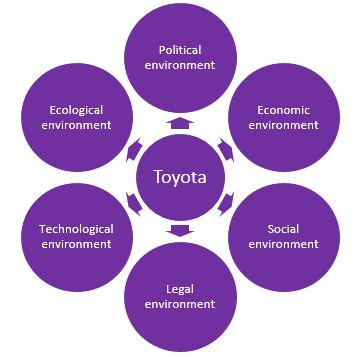Introduction
External Environment Analysis of Toyota will be conducted in this report through applying PESTEL and SWOT. Toyota is a Japanese multinational automobile company and one of the best companies in the sector. It sells automobiles in 170 countries and manufactures automobiles in 67 countries (Toyota Europe, 2020). The company have five regional headquarter and 20 design and R&D centres (Toyota Europe, 2020). Toyota has 370,870 employees across the world, and it generates revenue of about $272,612.00 (Fortune, 2020). In this report, different facts about Toyota have been demonstrated.
You may feel interested to read similar blogs:
External and Internal Environment Analysis of Tesla
External business environment of DHL
A sustainability and strategic report on Sainsbury’s
PESTLE Analysis of Toyota
The political environment, economic environment, social environment, legal environment, technological environment and ecological environment are the variables of PESTLE analysis. The influences of the variables on Toyota have been evaluated below:

Political environment: Toyota has manufacturing companies in 67 countries and their products in more than 170 countries, so the political environment of all countries influences the business of the company (Toyota Europe, 2020). Political stability and policies influence the operations of Toyota in many ways. For example, Japan and China do not share good relations with each other, which also affects Toyota. China is one of the largest car markets in the world, but Toyota is unable to create a positive image in customers’ minds because Chinese people do not take any Japanese products positively. As a result, Toyota cannot achieve its targeted growth in China, and the revenue of China market remains low. India’s demonetisation also affected Toyota because the demand of cars was reduced for the shortage of cash. Therefore, Toyota’s growth in India is also low.
Economic environment: Economic factors such as inflation rate, tax rate, interest rate, currency exchange rate, etcetera effects Toyota. Among all economic factors, currency exchange rate fluctuations have the greatest influence on their business. For example, 1 USD is equal to 108.87 Yen of Chinese (Pound Sterling Live, 2010). Because of the failure of the Japanese Yen against the USD, Toyota got a benefit of ¥900.0 billion in 2014 (Toyota Global, 2014). It seems that the fall of Yen benefited the company enormously. The high inflation rate of India directly affected the business of Toyota, and the sales rate of the company was reduced by 58% in the year (Business Standard, 2014). As a result, the profit of the year was reduced.
Social environment: Social factors of the host countries influences the execution of Toyota. The company consider the cultural difference among countries. Therefore, they employ employees from the same country in the host country’s office (Monden, 2019). As a result, employees of the country can utilize their knowledge in their work, and the company does not need to train the employees about the culture of the area. I produce cars after considering the demand of customers. For example, Toyota produces cars with large size and affordable price for India because the culture of Indian people is living with family and the budget of Indian customers’ are less.
Legal environment: Toyota has to maintain the laws and legislations of the operating business otherwise, they have to compensate or accept penalties. For example, in 2014, Toyota had to compensate $1.2 billion criminal penalty (The New York Times, 2014). Toyota had to pay a huge amount for hiding safety defects from customers. There were some safety defects in their cars which was risky for customers’ life and 12 customers died because of the defect of the cars (The New York Times, 2014). After that, the company have not repeated the mistake again, and it should operate its business in a legal way to avoid penalties in future.
Technological environment: Technology changes rapidly, and Toyota keeps itself updated with the latest technology (Mehri, 2018). By using the latest technology in its car, the brand has increased its value greatly across the world. It follows the Kaizen principle therefore, they become able to focus on their continuous development of technology. Toyota utilized the technology in a proper way and became successful in launching the world’s first hydrogen car. The company has 20 design and R&D centres and investing a huge amount in R&D to invent cars of alternative of fuel cars and more environmentally friendly (Toyota Europe, 2020).
Ecological environment: Toyota has announced its environmental challenge and has a target to reduce its impact on the environment by 2050 (Toyota Motor Corporation, 2020). The company committed to reducing its carbon emission by up to 90% of new cars within 2050 in order to reduce pollution from the world and make it a better place to live (My Alexander Toyota, 2018). Toyota has a target of removing all carbon emissions from their cars’ life cycle. It has taken challenges to reduce water use and establish a recycle-based society and systems.
Reference
Pound Sterling Live, 2010. The U.S. Dollar to Japanese Yen Historical Exchange Rates Conversion Page for 2019. Retrieved from: https://www.poundsterlinglive.com/best-exchange-rates/best-us-dollar-to-japanese-yen-history-2019. [Assessed on: 2 March 2020]
The New York Times, 2014. Toyota Is Fined $1.2 Billion for Concealing Safety Defects. Retrieved from: https://www.nytimes.com/2014/03/20/business/toyota-reaches-1-2-billion-settlement-in-criminal-inquiry.html. [Assessed on: 3 March 2020]
Toyota Europe, 2020. Toyota in the world. Retrieved from: https://www.toyota-europe.com/world-of-toyota/this-is-toyota/toyota-in-the-world. [Assessed on: 1 March 2020]
Toyota Global, 2014. Annual Report of Toyota 2014. Retrieved from: https://www.toyota-global.com/pages/contents/investors/ir_library/annual/pdf/2014/ar14_e.pdf. [Assessed on: 2 March 2020]
Toyota Motor Corporation, 2020. Toyota Environmental Challenge 2050. Retrieved from: https://global.toyota/en/sustainability/esg/challenge2050/. [Assessed on: 3 March 2020]
